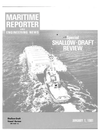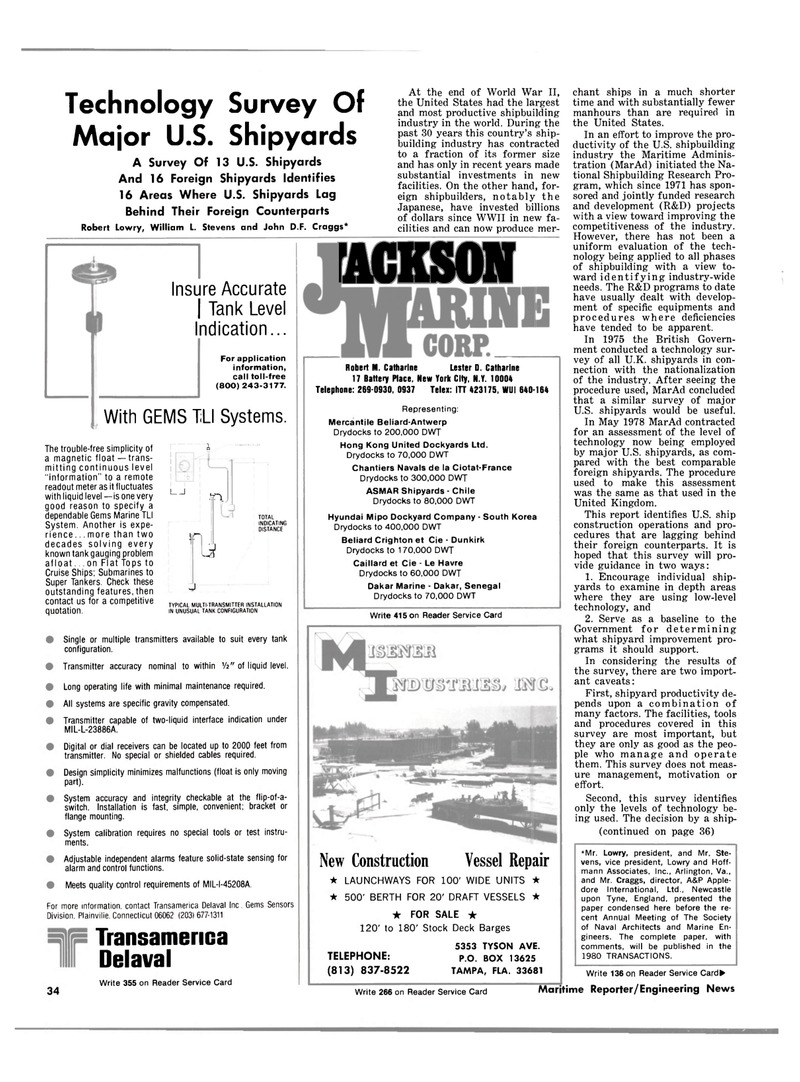
Page 34: of Maritime Reporter Magazine (January 1981)
Read this page in Pdf, Flash or Html5 edition of January 1981 Maritime Reporter Magazine
Technology Survey Of
Major U.S. Shipyards
A Survey Of 13 U.S. Shipyards
And 16 Foreign Shipyards Identifies 16 Areas Where U.S. Shipyards Lag
Behind Their Foreign Counterparts
Robert Lowry, William L. Stevens and John D.F. Craggs*
At the end of World War II, the United States had the largest and most productive shipbuilding industry in the world. During the past 30 years this country's ship- building industry has contracted to a fraction of its former size and has only in recent years made substantial investments in new facilities. On the other hand, for- eign shipbuilders, notably the
Japanese, have invested billions of dollars since WWII in new fa- cilities and can now produce mer-
Insure Accurate | Tank Level
Indication...
For application information, call toll-free (800) 243-3177.
With GEMS TLI Systems.
The trouble-free simplicity ot a magnetic float —trans- mitting continuous level "information" to a remote readout meter as it fluctuates with liquid level—is one very good reason to specify a dependable Gems Marine TLI
System. Another is expe- rience ... more than two decades solving every known tank gauging problem afloat... on Flat Tops to
Cruise Ships; Submarines to
Super Tankers. Check these outstanding features, then contact us for a competitive quotation. i
L J n n
TOTAL
INDICATING
DISTANCE li
J
TYPICAL MULTI-TRANSMITTER INSTALLATION
IN UNUSUAL TANK CONFIGURATION
Single or multiple transmitters available to suit every tank configuration.
Transmitter accuracy nominal to within Vt" of liquid level.
Long operating life with minimal maintenance required.
All systems are specific gravity compensated.
Transmitter capable of two-liquid interface indication under
MIL-L-23886A.
Digital or dial receivers can be located up to 2000 feet from transmitter. No special or shielded cables required.
Design simplicity minimizes malfunctions (float is only moving part).
System accuracy and integrity checkable at the flip-of-a- switch. Installation is fast, simple, convenient; bracket or flange mounting.
System calibration requires no special tools or test instru- ments.
Adjustable independent alarms feature solid-state sensing for alarm and control functions.
Meets quality control requirements of MIL-I-45208A.
For more information, contact Transamerica Delaval Inc. Gems Sensors
Division. Plainvilie. Connecticut 06062 (203) 677-1311
Transamerica
Delaval fACKSON 34
Write 355 on Reader Service Card
Robert M. Catharine Lester D. Catharine 17 Battery Place, New York City, N.Y. 10004
Telephone: 269-0930, 0937 Telex: in 423175, WUI 640-164
Representing:
Mercantile Beliard-Antwerp
Drydocks to 200,000 DWT
Hong Kong United Dockyards Ltd.
Drydocks to 70,000 DWT
Chantiers Navals de la Ciotat-France
Drydocks to 300,000 DWT
ASMAR Shipyards - Chile
Drydocks to 80,000 DWT
Hyundai Mipo Dockyard Company - South Korea
Drydocks to 400,000 DWT
Beliard Crighton et Cie - Dunkirk
Drydocks to 1 70,000 DWT
Caillard et Cie - Le Havre
Drydocks to 60,000 DWT
Dakar Marine - Dakar, Senegal
Drydocks to 70,000 DWT
Write 415 on Reader Service Card
New Construction Vessel Repair • LAUNCHWAYS FOR 100' WIDE UNITS • • 500' BERTH FOR 20' DRAFT VESSELS • • FOR SALE * 120' to 180' Stock Deck Barges
TELEPHONE: (813) 837-8522 5353 TYSON AVE.
P.O. BOX 13625
TAMPA, FLA. 33681 chant ships in a much shorter time and with substantially fewer manhours than are required in the United States.
In an effort to improve the pro- ductivity of the U.S. shipbuilding industry the Maritime Adminis- tration (MarAcl) initiated the Na- tional Shipbuilding Research Pro- gram, which since 1971 has spon- sored and jointly funded research and development (R&D) projects with a view toward improving the competitiveness of the industry.
However, there has not been a uniform evaluation of the tech- nology being applied to all phases of shipbuilding with a view to- ward identifying industry-wide needs. The R&D programs to date have usually dealt with develop- ment of specific equipments and procedures where deficiencies have tended to be apparent.
In 1975 the British Govern- ment conducted a technology sur- vey of all U.K. shipyards in con- nection with the nationalization of the industry. After seeing the procedure used, Mar Ad concluded that a similar survey of major
U.S. shipyards would be useful.
In May 1978 MarAd contracted for an assessment of the level of technology now being employed by major U.S. shipyards, as com- pared with the best comparable foreign shipyards. The procedure used to make this assessment was the same as that used in the
United Kingdom.
This report identifies U.S. ship construction operations and pro- cedures that are lagging behind their foreign counterparts. It is hoped that this survey will pro- vide guidance in two ways: 1. Encourage individual ship- yards to examine in depth areas where they are using low-level technology, and 2. Serve as a baseline to the
Government for determining what shipyard improvement pro- grams it should support.
In considering the results of the survey, there are two import- ant caveats:
First, shipyard productivity de- pends upon a combination of many factors. The facilities, tools and procedures covered in this survey are most important, but they are only as good as the peo- ple who manage and operate them. This survey does not meas- ure management, motivation or effort.
Second, this survey identifies only the levels of technology be- ing used. The decision by a ship- continued on page 36) *Mr. Lowry, president, and Mr. Ste- vens, vice president, Lowry and Hoff- mann Associates, Inc., Arlington, Va., and Mr. Craggs, director, A&P Apple- dore International, Ltd., Newcastle upon Tyne, England, presented the paper condensed here before the re- cent Annual Meeting of The Society of Naval Architects and Marine En- gineers. The complete paper, with comments, will be published in the 1980 TRANSACTIONS.
Write 266 on Reader Service Card
Write 136 on Reader Service Card*
Maritime Reporter/Engineering News

 33
33

 35
35
